Abstract
The type-specific antigen of Streptococcus mutans strain MT703, serotype e, has been chromatographically purified and characterized. Two chromatographic fractions were obtained from saline extracts which reacted with both anti-MT703 whole-cell serum and Lancefield group E serum. The major fraction (eI) was identified as a polysaccharide composed of 37% glucose, 56% rhamnose, 5% protein, and 0.3% phosphorus, whereas the minor fraction (eII) contained 66% protein in addition to 10% glucose and 17% rhamnose. The immunological specificity of these antigens was found to be the same by immunodiffusion in agar gel. Another fraction with a negative charge (eIII) reacted with polyglycerophosphate antisera from Streptococcus mutans and Streptococcus pyogenes. For comparison, the MT703 antigen in a hot trichloroacetic acid extract (eA) and the group E antigen from a saline extract of cells of strain K129 (EI) were similarly purified by anionic ion-exchange chromatography. Although the ratio of glucose and rhamnose in eA was 1:0.9 and in eI and eII approximately 1:1.5, reactions of identity were obtained in gel diffusion against specific anti-e serum. This difference in ratio is probably a result of the extraction procedures. Both the type e and group E antisera were reactive with both eI and EI antigens. The adsorption of group E antiserum with MT703 cells removed all E antibody, whereas type e-specific antibody remained after adsorption with K129 cells. These results suggest that eI antigen possesses both e and E specificities, whereas EI possesses E only. These findings were supported by the quantitative precipitin test and immunodiffusion and/or immunoelectrophoretic patterns in agar gel. Methyl-beta-D-glucopyranoside markedly inhibited the precipitin reaction in both type e and group E sera. However, a significantly stronger inhibition by cellobiose of type e serum than of group E serum indicates that a beta-linked glucose-glucose dimer is the predominant antigenic determinant of the e specificity. The presence of both e and E specificities on a single polysaccharide molecule was demonstrated by the use of purified e antigen released from a specific e-anti-e complex. This antigen reacted with a group E-specific serum as well as a type e-specific serum. An examination of five S. mutans type e strains showed the presence of group E specificity also, whereas the I, II, and IV serotypes of group E streptococci only possessed the group E specificity.
Full text
PDF
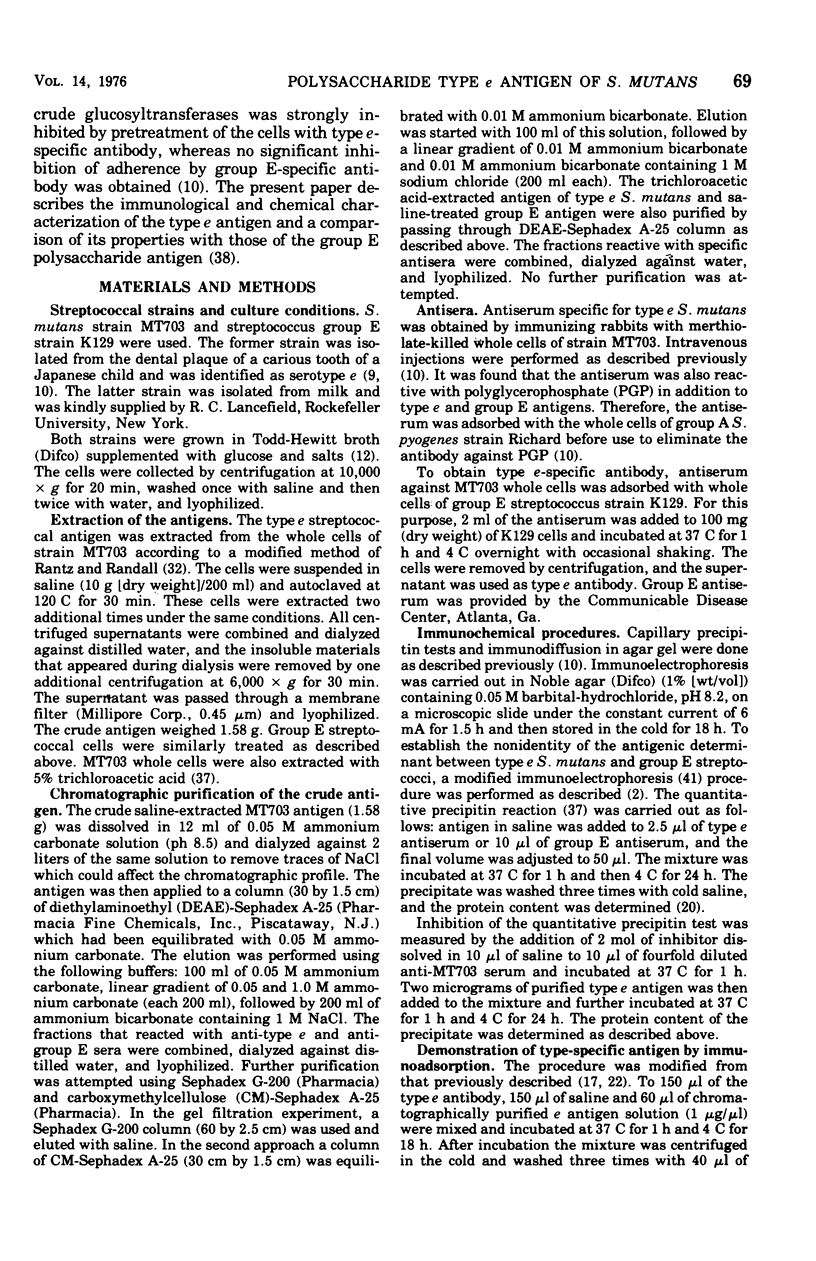

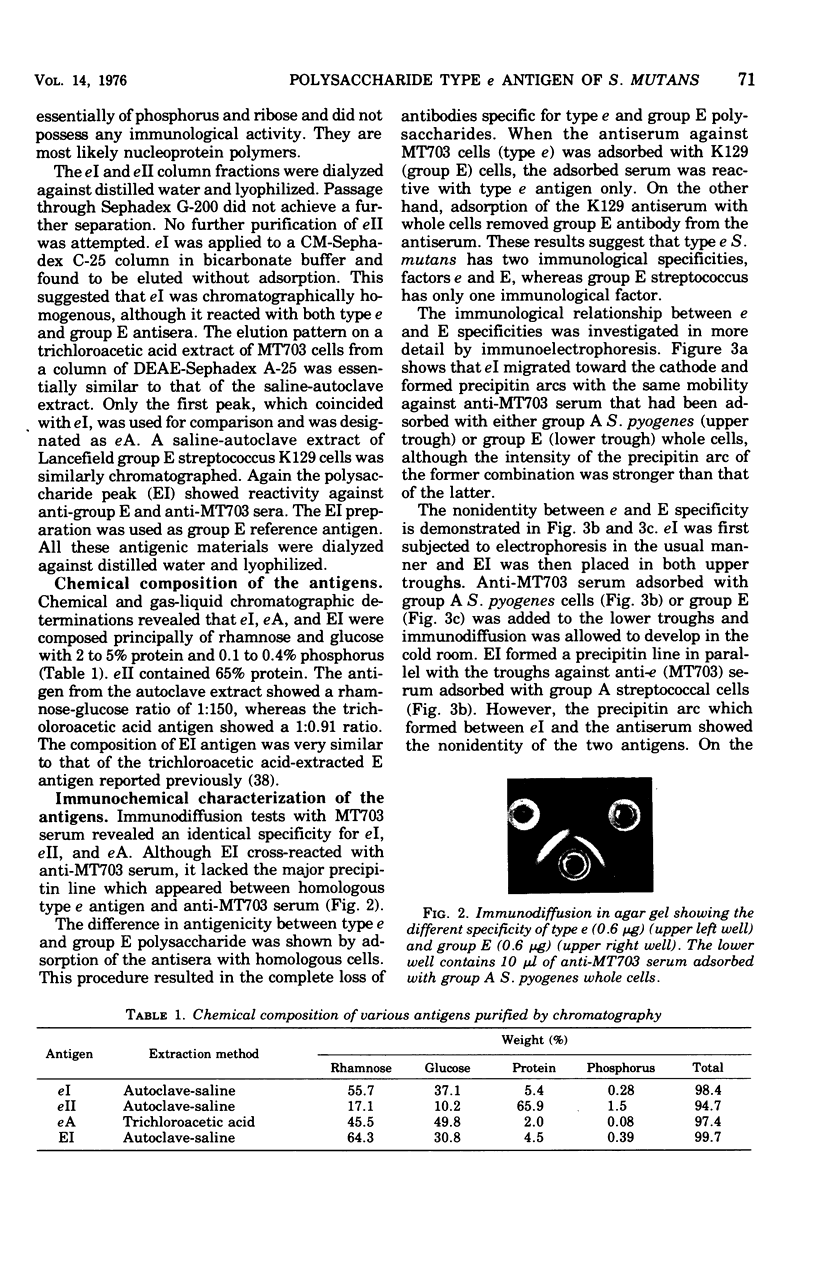
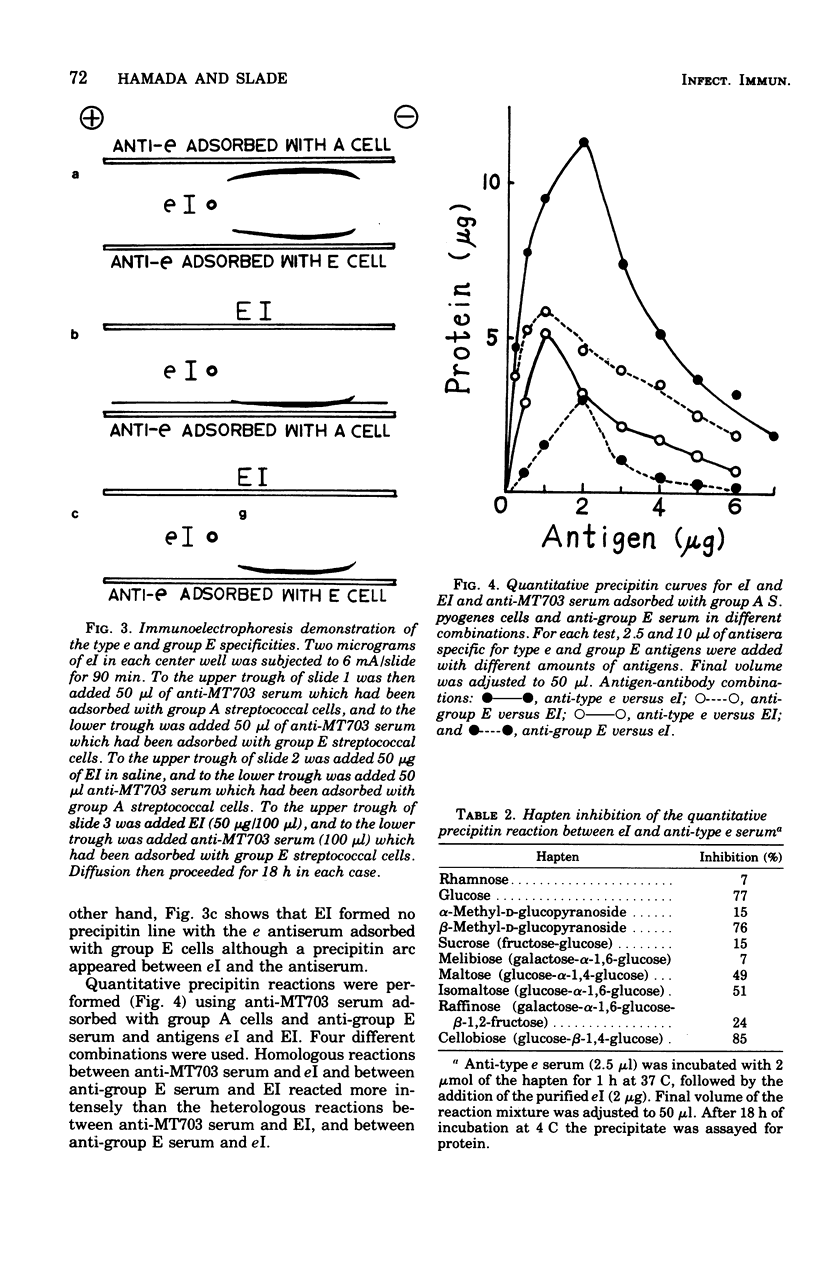
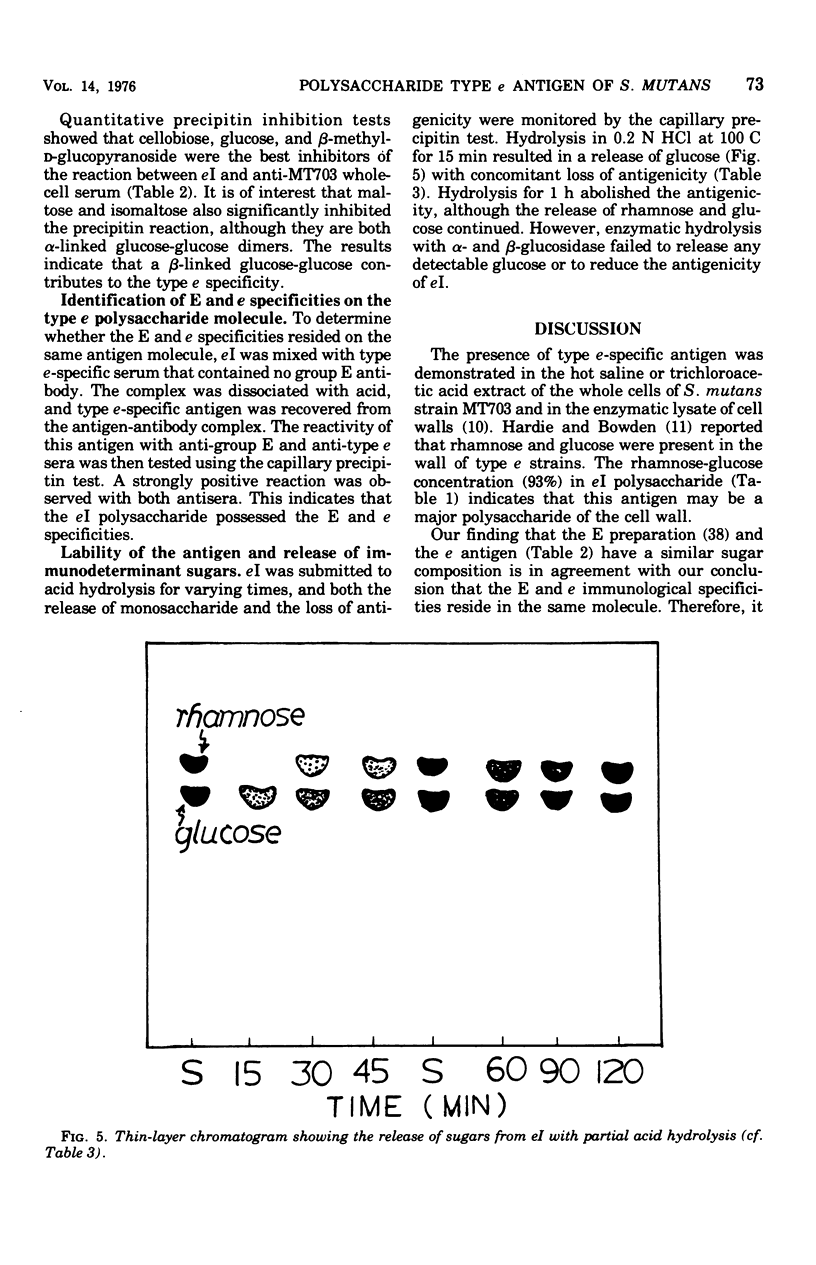
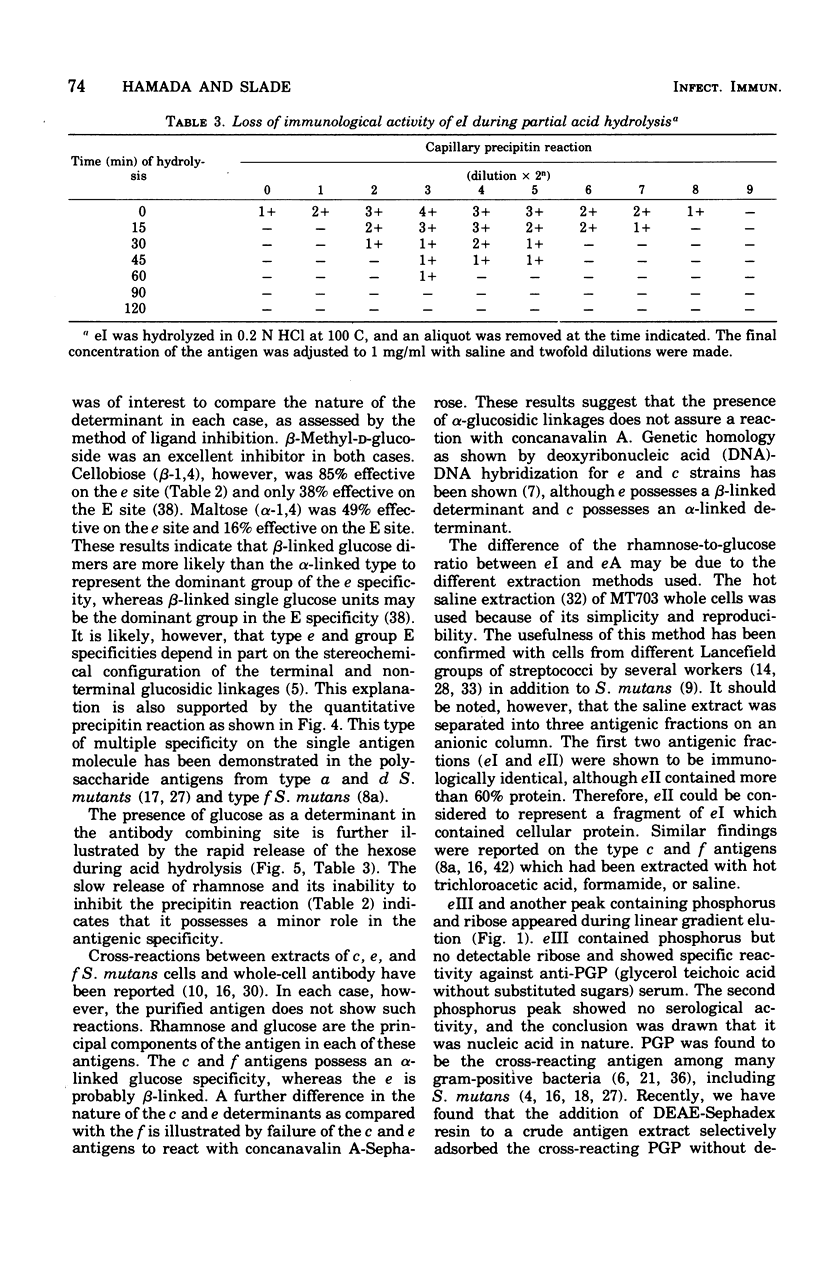
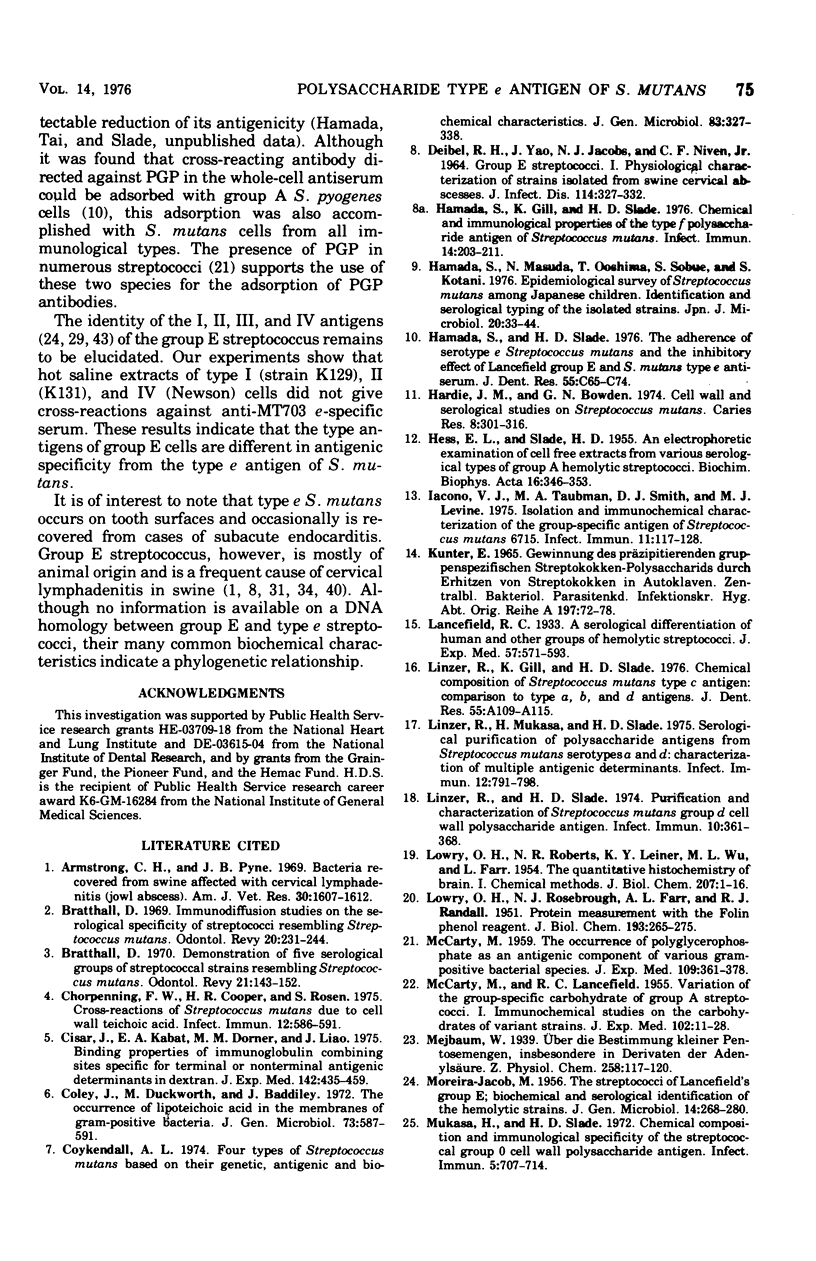
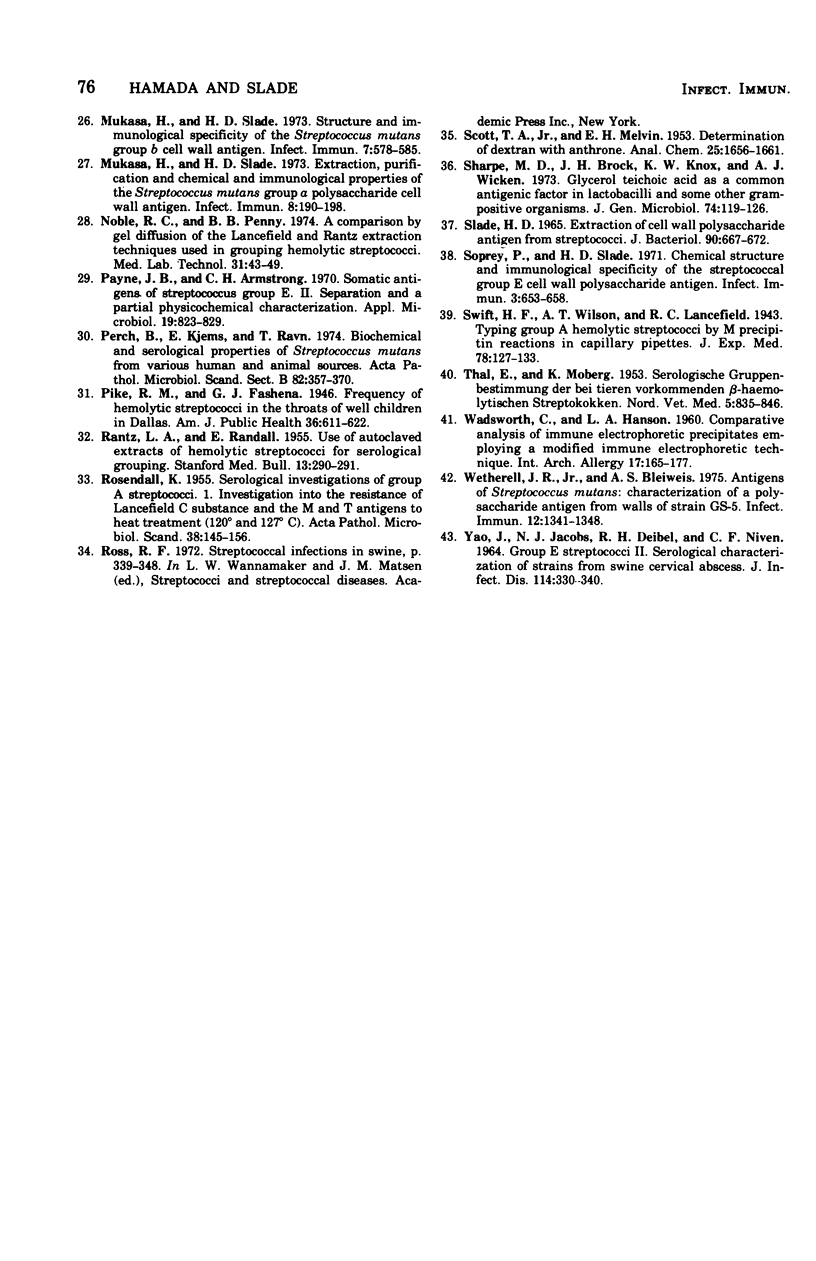
Images in this article
Selected References
These references are in PubMed. This may not be the complete list of references from this article.
- Armstrong C. H., Payne J. B. Bacteria recovered from swine affected with cervical lymphadenitis (jowl abscess). Am J Vet Res. 1969 Sep;30(9):1607–1612. [PubMed] [Google Scholar]
- Bratthall D. Demonstration of five serological groups of streptococcal strains resembling Streptococcus mutans. Odontol Revy. 1970;21(2):143–152. [PubMed] [Google Scholar]
- Bratthall D. Immunodiffusion studies on the serological specificity of streptococci resembling Streptococcus mutans. Odontol Revy. 1969;20(3):231–243. [PubMed] [Google Scholar]
- Chorpenning F. W., Cooper H. R., Rosen S. Cross-reactions of Streptococcus mutans due to cell wall teichoic acid. Infect Immun. 1975 Sep;12(3):586–591. doi: 10.1128/iai.12.3.586-591.1975. [DOI] [PMC free article] [PubMed] [Google Scholar]
- Cisar J., Kabat E. A., Dorner M. M., Liao J. Binding properties of immunoglobulin combining sites specific for terminal or nonterminal antigenic determinants in dextran. J Exp Med. 1975 Aug 1;142(2):435–459. doi: 10.1084/jem.142.2.435. [DOI] [PMC free article] [PubMed] [Google Scholar]
- Coley J., Duckworth M., Baddiley J. The occurrence of lipoteichoic acids in the membranes of gram-positive bacteria. J Gen Microbiol. 1972 Dec;73(3):587–591. doi: 10.1099/00221287-73-3-587. [DOI] [PubMed] [Google Scholar]
- Coykendall A. L. Four types of Streptococcus mutans based on their genetic, antigenic and biochemical characteristics. J Gen Microbiol. 1974 Aug;83(2):327–338. doi: 10.1099/00221287-83-2-327. [DOI] [PubMed] [Google Scholar]
- DEIBEL R. H., YAO J., JACOBS N. J., NIVEN C. F., Jr GROUP E STREPTOCOCCI. I. PHYSIOLOGICAL CHARACTERIZATION OF STRAINS ISOLATED FROM SWINE CERVICAL ABSCESSES. J Infect Dis. 1964 Oct;114:327–332. doi: 10.1093/infdis/114.4.327. [DOI] [PubMed] [Google Scholar]
- HESS E. L., SLADE H. D. An electrophoretic examination of cell-free extracts from various serological types of group A hemolytic streptococci. Biochim Biophys Acta. 1955 Mar;16(3):346–353. doi: 10.1016/0006-3002(55)90237-7. [DOI] [PubMed] [Google Scholar]
- Hamada S., Gill K., Slade H. D. Chemical and immunological properties of the type f polysaccharide antigen of Streptococcus mutans. Infect Immun. 1976 Jul;14(1):203–211. doi: 10.1128/iai.14.1.203-211.1976. [DOI] [PMC free article] [PubMed] [Google Scholar]
- Hamada S., Masuda N., Ooshima T., Sobue S., Kotani S. Epidemiological survey of Streptococcus mutans among Japanese children. Identification and serological typing of the isolated strains. Jpn J Microbiol. 1976 Feb;20(1):33–44. doi: 10.1111/j.1348-0421.1976.tb00905.x. [DOI] [PubMed] [Google Scholar]
- Hamada S., Slade H. D. Adherence of serotype e Streptococcus mutans and the inhibitory effect of Lancefield group E and S mutans type e antiserum. J Dent Res. 1976 Apr;55(Spec No):C65–C74. doi: 10.1177/002203457605500328011. [DOI] [PubMed] [Google Scholar]
- Hardie J. M., Bowden G. H. Cell wall and serological studies on Streptococcus mutans. Caries Res. 1974;8(4):301–316. doi: 10.1159/000260120. [DOI] [PubMed] [Google Scholar]
- Iacono V. J., Taubman M. A., Smith D. J., Levine M. J. Isolation and immunochemical characterization of the group-specific antigen of Streptococcus mutants 6715. Infect Immun. 1975 Jan;11(1):117–128. doi: 10.1128/iai.11.1.117-128.1975. [DOI] [PMC free article] [PubMed] [Google Scholar]
- Kunter E. Gewinnung des präzipitierenden gruppenspezifischen Streptokokken-Polysaccharids durch Erhitzen von Streptokokken im Autoklaven. Zentralbl Bakteriol Orig. 1965 Jul;197(1):72–78. [PubMed] [Google Scholar]
- LOWRY O. H., ROBERTS N. R., LEINER K. Y., WU M. L., FARR A. L. The quantitative histochemistry of brain. I. Chemical methods. J Biol Chem. 1954 Mar;207(1):1–17. [PubMed] [Google Scholar]
- LOWRY O. H., ROSEBROUGH N. J., FARR A. L., RANDALL R. J. Protein measurement with the Folin phenol reagent. J Biol Chem. 1951 Nov;193(1):265–275. [PubMed] [Google Scholar]
- Linzer R., Gill K., Slade H. D. Chemical composition of Streptococcus mutans type c antigen: comparison to type a, b, and d antigens. J Dent Res. 1976 Jan;55:A109–A115. doi: 10.1177/002203457605500103011. [DOI] [PubMed] [Google Scholar]
- Linzer R., Mukasa H., Slade H. D. Serological purification of polysaccharide antigens from Streptococcus mutans serotypes a and d: characterization of multiple antigenic determinants. Infect Immun. 1975 Oct;12(4):791–798. doi: 10.1128/iai.12.4.791-798.1975. [DOI] [PMC free article] [PubMed] [Google Scholar]
- Linzer R., Slade H. D. Purification and characterization of Streptococcus mutans group d cell wall polysaccharide antigen. Infect Immun. 1974 Aug;10(2):361–368. doi: 10.1128/iai.10.2.361-368.1974. [DOI] [PMC free article] [PubMed] [Google Scholar]
- MOREIRA-JACOB M. The streptococci of Lancefield's group E; biochemical and serological identification of the haemolytic strains. J Gen Microbiol. 1956 Apr;14(2):268–280. doi: 10.1099/00221287-14-2-268. [DOI] [PubMed] [Google Scholar]
- McCARTY M., LANCEFIELD R. C. Variation in the group-specific carbohydrate of group A streptococci. I. Immunochemical studies on the carbohydrates of variant strains. J Exp Med. 1955 Jul 1;102(1):11–28. doi: 10.1084/jem.102.1.11. [DOI] [PMC free article] [PubMed] [Google Scholar]
- McCARTY M. The occurrence of polyglycerophosphate as an antigenic component of various gram-positive bacterial species. J Exp Med. 1959 Apr 1;109(4):361–378. doi: 10.1084/jem.109.4.361. [DOI] [PMC free article] [PubMed] [Google Scholar]
- Mukasa H., Slade H. D. Chemical composition and immunological specificity of the streptococcal group O cell wall polysaccharide antigen. Infect Immun. 1972 May;5(5):707–714. doi: 10.1128/iai.5.5.707-714.1972. [DOI] [PMC free article] [PubMed] [Google Scholar]
- Mukasa H., Slade H. D. Extraction, purification, and chemical and immunological properties of the Streptococcus mutans group "a" polysaccharide cell wall antigen. Infect Immun. 1973 Aug;8(2):190–198. doi: 10.1128/iai.8.2.190-198.1973. [DOI] [PMC free article] [PubMed] [Google Scholar]
- Mukasa H., Slade H. D. Structure and immunological specificity of the Streptococcus mutans group b cell wall antigen. Infect Immun. 1973 Apr;7(4):578–585. doi: 10.1128/iai.7.4.578-585.1973. [DOI] [PMC free article] [PubMed] [Google Scholar]
- Noble R. C., Penny B. B. A comparison by gel diffusion of the Lancefield and Rantz extraction techniques used in grouping haemolytic streptococci. Med Lab Technol. 1974 Jan;31(1):43–49. [PubMed] [Google Scholar]
- Payne J. B., Armstrong C. H. Somatic antigens of Streptococcus group E. II. Separation and a partial physicochemical characterization. Appl Microbiol. 1970 May;19(5):823–829. doi: 10.1128/am.19.5.823-829.1970. [DOI] [PMC free article] [PubMed] [Google Scholar]
- Perch B., Kjems E., Ravn T. Biochemical and serological properties of Streptococcus mutans from various human and animal sources. Acta Pathol Microbiol Scand B Microbiol Immunol. 1974 Jun;82(3):357–370. doi: 10.1111/j.1699-0463.1974.tb02338.x. [DOI] [PubMed] [Google Scholar]
- Pike R. M., Fashena G. J. Frequency of Hemolytic Streptococci in the Throats of Well Children in Dallas. Am J Public Health Nations Health. 1946 Jun;36(6):611–622. [PMC free article] [PubMed] [Google Scholar]
- RANTZ L. A., RANDALL E. Use of autoclaved extracts of hemolytic streptococci for serological grouping. Stanford Med Bull. 1955 May;13(2):290–291. [PubMed] [Google Scholar]
- Sharpe M. E., Brock J. H., Knox K. W., Wicken A. J. Glycerol teichoic acid as a common antigenic factor in lactobacilli and some other gram-positive organisms. J Gen Microbiol. 1973 Jan;74(1):119–126. doi: 10.1099/00221287-74-1-119. [DOI] [PubMed] [Google Scholar]
- Slade H. D. Extraction of Cell-Wall Polysaccharide Antigen from Streptococci. J Bacteriol. 1965 Sep;90(3):667–672. doi: 10.1128/jb.90.3.667-672.1965. [DOI] [PMC free article] [PubMed] [Google Scholar]
- Soprey P., Slade H. D. Chemical structure and immunological specificity of the streptococcal group e cell wall polysaccharide antigen. Infect Immun. 1971 May;3(5):653–658. doi: 10.1128/iai.3.5.653-658.1971. [DOI] [PMC free article] [PubMed] [Google Scholar]
- WADSWORTH C., HANSON L. A. Comparative analysis of immune electrophoretic precipitates employing a modified immune electrophoretic technique. Int Arch Allergy Appl Immunol. 1960;17:165–177. doi: 10.1159/000229122. [DOI] [PubMed] [Google Scholar]
- Wetherell J. R., Jr, Bleiweis A. S. Antigens of Streptococcus mutans: characterization of a polysaccharide antigen from walls of strain GS-5. Infect Immun. 1975 Dec;12(6):1341–1348. doi: 10.1128/iai.12.6.1341-1348.1975. [DOI] [PMC free article] [PubMed] [Google Scholar]
- YAO J., JACOBS N. J., DEIBEL R. H., NIVEN C. F., Jr GROUP E STREPTOCOCCI. II. SEROLOGICAL CHARACTERIZATION OF STRAINS FROM SWINE CERVICAL ABSCESSES. J Infect Dis. 1964 Oct;114:333–340. doi: 10.1093/infdis/114.4.333. [DOI] [PubMed] [Google Scholar]



